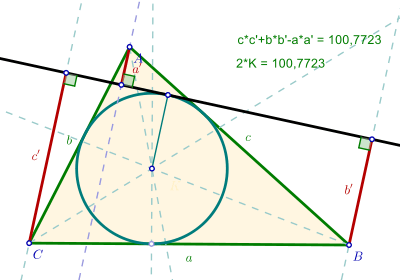Harcourt's theorem
Harcourt's theorem is a formula in geometry for the area of a triangle, as a function of its side lengths and the perpendicular distances of its vertices from an arbitrary line tangent to its incircle.[1]

The theorem is named after J. Harcourt, an Irish professor.[2]
Statement
Let a triangle be given with vertices A, B, and C, opposite sides of lengths a, b, and c, area K, and a line that is tangent to the triangle's incircle at any point on that circle. Denote the signed perpendicular distances of the vertices from the line as a ', b ', and c ', with a distance being negative if and only if the vertex is on the opposite side of the line from the incenter. Then
Degenerate case
If the tangent line contains one of the sides of the triangle, then two of the distances are zero and the formula collapses to the familiar formula that twice the area of a triangle is a base (the coinciding triangle side) times the altitude from that base.
Extension
If the line is instead tangent to the excircle opposite, say, vertex A of the triangle, then[1]:Thm.3
Dual property
If rather than a', b', c' referring to distances from a vertex to an arbitrary incircle tangent line, they refer instead to distances from a sideline to an arbitrary point, then the equation
remains true.[3]:p. 11
References
- Dergiades, Nikolaos; Salazar, Juan Carlos (2003), "Harcourt's theorem" (PDF), Forum Geometricorum, 3: 117–124, MR 2004117.
- G.-M., F. (1912), "Théorème de Harcourt", Exercises de géométrie: comprenant l'exposé des méthodes géométriques et 2000 questions résolues, Cours de mathématiques elementaires (in French) (5th ed.), Maison A. Mame et fils (Tours) & J. de Gigord (Paris), p. 750.
- Whitworth, William Allen. Trilinear Coordinates and Other Methods of Modern Analytical Geometry of Two Dimensions, Forgotten Books, 2012 (orig. Deighton, Bell, and Co., 1866). http://www.forgottenbooks.com/search?q=Trilinear+coordinates&t=books